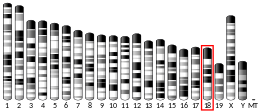DIAPH1
Protein and coding gene in humans From Wikipedia, the free encyclopedia
Protein diaphanous homolog 1 is a protein that in humans is encoded by the DIAPH1 gene.[5][6][7]
Function
This gene is a homolog of the Drosophila diaphanous gene and belongs to the protein family of the formins, characterized by the formin homology 2 (FH2) domain. It has been linked to autosomal dominant, fully penetrant, nonsyndromic low-frequency progressive sensorineural hearing loss. Actin polymerization involves proteins known to interact with diaphanous protein in Drosophila and mouse. It has therefore been speculated that this gene may have a role in the regulation of actin polymerization in hair cells of the inner ear. Alternatively spliced transcript variants encoding distinct isoforms have been found for this gene.[7]
Interactions
Clinical significance
Mutations in this gene have been associated with macrothrombocytopenia and hearing loss,[9] microcephaly, blindness, and early onset seizures[10]
Its actions on platelet formation appear to occur at the level of the megakaryocyte where it is involved in cytoskeleton formation.[11]
See also
References
Further reading
External links
Wikiwand - on
Seamless Wikipedia browsing. On steroids.








